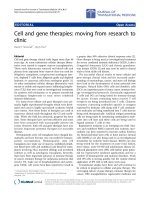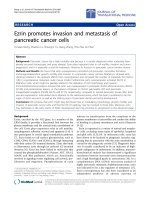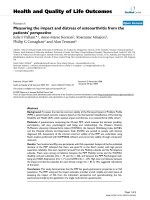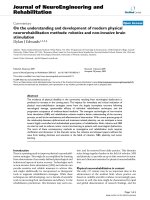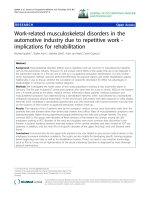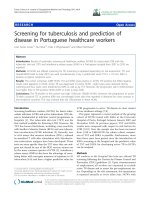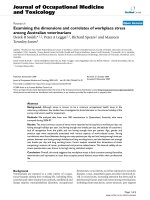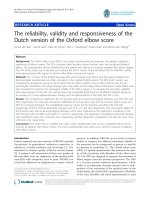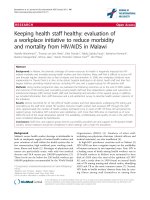Báo cáo hóa học: " Effective harvesting, detection, and conversion of IR radiation due to quantum dots with built-in charge" docx
Bạn đang xem bản rút gọn của tài liệu. Xem và tải ngay bản đầy đủ của tài liệu tại đây (2.57 MB, 13 trang )
NANO EXPRESS Open Access
Effective harvesting, detection, and conversion of IR
radiation due to quantum dots with built-in charge
Kimberly Sablon
1
, Andrei Sergeev
2
, Nizami Vagidov
2
, Andrei Antipov
2
, John Little
1
and Vladimir Mitin
2*
Abstract
We analyze the effect of doping on photoelectron kinetics in quantum dot [QD] structures and find two strong
effects of the built-in-dot charge. First, the built-in-dot charge enhances the infrared [IR] transitions in QD
structures. This effect significantly increases electron coupling to IR radiation and improves harvesting of the IR
power in QD solar cells. Second, the built-in charge creates potential barriers around dots, and these barriers
strongly suppress capture processes for photocarriers of the same sign as the built-in-dot charge. The second effect
exponentially increases the photoelectron lifetime in unipolar devices, such as IR photodetectors. In bipolar devices,
such as solar cells, the solar radiation creates the built-in-dot charge that equates the electron and hole capture
rates. By providing additional charge to QDs, the appropriate doping can significantly suppress the capture and
recombination processes via QDs. These improvements of IR absorption and photocarrier kinetic s radically increase
the responsivity of IR photodetectors and photovoltaic efficiency of QD solar cells.
Keywords: quantum dot, infrared photodetector, solar cell, photoresponse, doping, potential barrier, capture
processes
Introduction
One of the main goals for the next generation of infrared
[IR] imaging systems and solar cell photovoltaic devices is
to increase the photoresponse to IR radiation [1]. To
enhance the IR photoresponse, it is necessary to (1)
improve electron coupling to IR radiation and (2) increase
the photocarrier lifetime, i.e., to suppress recombination
losses. However, it is not easy to increase IR absorption
without enhancement of recombination losses because by
introducing electron levels, which provide strong IR tran-
sitions, we inevitably create additional channels for inverse
processes that increase recombination losses.
This trade-off between IR absorption and recombination
processes are well understood for a number of technolo-
gies and corresponding materials. For example, in the
early 1960s, semiconductors with impurities which provide
electron levels inside a semiconductor bandgap and induce
IR transitions from localized impurity states to conducting
states re ceived significant attention. However, midgap
impurities drastically enhance the recombination
processes, i.e., the Shockley-Read-Hall recombination, and
deteriorate the photovoltaic conversion efficiency [2,3].
To accommodate the solar spectrum and utilize its IR
portion, modern photovoltaic technology mainly employs
multi-junction cells with dif ferent bandgaps [4]. In these
devices, each p-n junction cell is designed to effectively
harvest solar energy within a certain spectral window close
to the bandgap. According to theoretical modeling, in a
multi-junction solar cell with five or more junctions, the
ultimate photovoltaic efficiency may exceed 70%. How-
ever, current technology enables only triple-junction cells
(Ge-substrate junction-InGaAs-AlInGaP) with the maxi-
mum conversion efficiency of approximately 42% for con-
centrator cells. Strong technological limitations are caused
by the need for lattice m atch, thermal expansion match,
and current match in the cascade of heterojunctions [5,6].
Quantum-well structures are intensively investigated for
applications in IR imag ing a nd solar energy conversion.
Some enhancement in conversion efficiency was observed
in solar cells, based on planar quantum wells, due to
increased resonance absorption. Quantum-well IR sensing
is currently a well-established technology, which is widely
used for detection and imaging at liquid nitrogen tempera-
tures and below. However, at higher temperatures, the
* Correspondence:
2
University at Buffalo, State University of New York, Buffalo, NY, 14260-1920,
USA
Full list of author information is available at the end of the article
Sablon et al. Nanoscale Research Letters 2011, 6:584
/>© 2011 Sablo n et al; licensee Springer. This is an Open Access article distributed under the terms of the Creative Commons Attribution
License ( whic h permits unrestricted use, distribution, and reproduction in any medium,
provided the original work is properly cited.
photoresponse tremendously decreases due to a strong
reduction of photocarrier lifetime.
Recently, quantum-dot [QD] structures have attracted
much attention due to their ability to enhance absorption
of IR radiation via multiple energy levels introduced by
QDs [7-9]. In QDs, the carriers are confined in all three
dimensions. Electron states in separate dots can be con-
nect ed via manageable tunneling coupling betwee n QDs.
Therefore, QD media provide numerous possibilities for
nanoscale engineering of electron spectra by varying the
dot size and shape as well as the concentration of QDs
and geometry of a QD structure. Besides tunable IR
absorption, QD structures offer wide flexibility for nano-
engineering of electron processes via the built-in-dot
charge, correlation of dot positions, and selective doping.
The built-in charge induced by selective doping creates
potential barriers around dots and prevents capture of car-
riers of the same sign as the built-in-dot charge.
In very recent works, we h ave reported a radical
improvement on the responsivity of QD infrared photode-
tectors [QDIP] [10] and QD solar cell efficiency [11] due
to strong inter-dot doping, which creates substantial built-
in-dot charge. While up to now the incorporation of QDs
improves the solar cell’s performance just by a few percent
[12], we demonstrated that QDs with the built-in charge
of approximately six electrons per dot provide a 50%
increase in photovoltaic efficiency [11]. We also observed
appr oximately 25 times increase of the photoresponse of
QDIP when the built-in-dot charge increases from one
electron to six electrons per dot [10]. Research on the cap-
abilities of QD media with built-in-dot charge is still far
from completion.
In this work, we investigate the physical processes
behind these radical improvements. We study the poten-
tial relief created by the built-in-dot charge and calculate
potential barriers, which separate the conducting states in
the media from the localized QD states. Taking into
account the effects of the built-in-dot charge on the IR
absorption and photoelectron kinetics, we propose a sim-
ple model, which adequately describes effects of doping on
the operation of unipolar optoelectronic QD devices, such
as QDIPs. We also analyze our data related to the opera-
tion of a QD solar cell and present basic contours of the
model for the description of doping-induced effects in the
kinetics of bipola r p hotocarr iers in QD structures. We
conclude that in both cases, the built-in-dot charge
strongly enhances electron coupling to electromagnetic
radiation and suppresses the most effective capture pro-
cesses. These two factors allow us to improve the perfor-
mance of QDIPs and QD solar cells.
Unipolar kinetics in QD structures: IR photodetectors
To investigate the effects of the built-in-dot charge on the
unipolar kinetics in QD photodetectors, we investigate
anisotropic potential barriers in real QD structures used
for IR sensing. Our QD structures have been fabricated
using molecular beam epitaxy with growth temperatures
of 500 ± 10°C. InAs dots were grown on AlGaAs surfaces
by deposition of approximately 2.1 monolayers of I nAs.
During the no rmal growth of layers, the substrate was
rotated at 30 RPM to insure the uniform thickness of the
layers. The thickness of GaAs spacer between the QD
layers was chosen large enough to minimize the strain.
The obtained structures were doped in two different ways:
withintra-dotdoping(devicesB44andB52)andwith
inter-dot doping (devices B45 an d B53). In devices B44
and B52 (Figure 1a), the dopant sheet concentr ation was
2.7 × 10
11
cm
-2
and 5.4 × 10
11
cm
-2
, respectively. De vices
B45 and B53 have been grown with Si dopants directly in
the middle of each AlGaAs barrier layer (Figure 1b). In
devices B45 and B53, the dopant sheet concentration was
also 2.7 × 10
11
cm
-2
and 5.4 × 10
11
cm
-2
, respectively. QDs
had the truncated pyramid shape with an average of 3.6
nminheightand15nminwidth.TheQDswereran-
domly distributed over the QD layer. The average distance
between dots was 31 nm which corresponds to the sheet
concentration of 10
11
cm
-2
. Parameters of our samples are
summarized in Table 1. Det ails of the fabrication techni-
que and other parameters of t hese devices may be found
in Mitin et al. [10].
To calculate the built-in-dot charge and investigate the
potential profiles around dots, we used the nextnano
3
software, which allows for simulation of multilayer stru c-
tures combined with different materials of realistic geo-
metries in one, two, and three spatial dimensions [13].
This si mulation tool self-consistently solves Schrödinger,
Poisson, and current equations for electrons and holes.
The conduction and valence bands of the structures are
defined within a single-band or multi-band k·p mo del,
which includes a strain.
The three-dimen sional [3-D] potential profile in QD
structures calculated with nextnano
3
is shown in Figure 2.
Thelightblacklinesdenotethepreferablechannelsfor
the motion of photoelectrons (white dots) in the potential
relief created by the built-in-dot charge.
We simulated the band structure a nd potential distri-
bution in real devices taking into account the effects of
contacts. Figure 3 shows variations of the built-in-dot
charge and potential profile in the C-D cross section for
sample B53 with inter-dot doping (for clarity, we pre-
sent it in ten QD layers). As seen, the effect of contacts
is important only for one or two QD layers adjacent to
the contacts. Thus, the built-in-dot charge in QD layers
from the third to the eighth is directly determined by
the inter-dot doping. In Table 1, we present the built-
in-dot charge, which is determined by the number of
captured electrons and number of dopants (in the case
of intra-dot doping).
Sablon et al. Nanoscale Research Letters 2011, 6:584
/>Page 2 of 13
As seen in Figure 2, the potential barriers around QDs
are strongly asymmet ric. The barriers in the QD planes,
i.e., in the direction perpendicular to the current, are
substantially smaller than the barriers in th e direction of
the current. This a symmetry has strong consequences
for the kinetics of photocarriers.
In Figure 4, we compare the potential profiles in the
A-B c ross section (x-axis) and in the C-D cross section
(z-axis). Potential barriers in the A-B cross section are
significantly smaller, and therefore, they are presented
with a higher resolution.
Using the nextnano
3
,wehaveanalyzedthelocal
potential barriers around single QDs as a function of
the built-in charge. As expected, thes e local barriers are
independent on the QD position in the device and are
strongly asymmetric because of the asymmetry of the
QD shape. Figure 5 shows the height of local potential
barriers around single dots in dire ctions perpendicular
and parallel to the QD planes as a function of the built-
in-dot charge. Linear character of dependences is
expected. In Figure 5, we highlight the strong anisotropy
of the barriers, which is critically important for capture
processes and photoelectron kinetics.
The photoelectron capture into the charged dot may
be realized either via tunneling through the barrier or
via thermal excitation above the barrier. The relative
probability of these two processes depends on the char-
acteristic size of th e dot [14]. At r oom temperature, if a
dot radius is smaller than approxi mately 5 nm, the elec-
tron capture by the dot is analogous to the capture by
the repulsive impurity [15]. In this case, the capture rate
is proportional to exp[-(k
B
T/E
B
)
1/3
], where E
B
is Bohr’ s
energy; E
B
=2π
2
n
2
e
4
m/h
2
,wheren is the number of
electrons captured in a dot, m is the electron mass, and
is the permittivity [15]. In the opposite case, which is
usually realized in QD structures, the thermally acti-
vated processes dominate over tunneling and the cap-
ture rate follows the exponential dependence [14,16,17]:
1
τ
capt
∝ exp
−
V(Q)
k
B
T
,
(1)
where V(Q) i s the height of the local potential barrier,
which is a function of the built-in-dot charge Q=en
q
.
As shown in Figure 5, the height of the potential bar-
rier in the direction parallel to the QD plane is
Figure 1 QD structures. QD structures with intra-dot doping, i.e., doping of QD layers (a) and inter-dot doping, i.e., doping between QD layers (b).
Table 1 QDIP devices
Device B44 B45 B52 B53
Doping Intra-dot Inter-dot Intra-dot Inter-dot
Donor concentration (10
11
cm
-2
) 2.7 2.7 5.4 5.4
Number of electrons in dot, n 2.7 2.8 4.7 6.1
Built-in-dot charge, n
q
1.8 2.8 3.45 6.1
Sablon et al. Nanoscale Research Letters 2011, 6:584
/>Page 3 of 13
substantially smaller than that in the perpendicular
direction. Therefore, we expect that the capture pro-
cesses in QD planes will dominate in the relaxation pro-
cesses. Based on Figure 5, the corresponding barrier
height is V
||
= bn
q
,whereb = 2.5 meV. In the case o f
the intra-dot doping, the dot charge n
q
is equal to the
dot population n reduced by the number of dopants p
in the dot, i.e., n
q
= n-p. In the case of the inter-dot
doping, the built-in-dot charge q is obviously equal to n.
Thus, based on the above consideration, we expect
that the effects of doping on the photocurrent in QD
structures are described by:
I = Anexp
bn
q
k
B
T
.
(2)
Here, A is some constant which does not depend on dop-
ing. The pre-exponential factor in Equation 2 describes the
increase of the absorption with increasing number of elec-
trons in the dot n. The expone ntial factor describes the
effect of potential b arriers around dots on the photoelec-
tron lifetime. It is proportional to the dot charge n
q
deter-
mined by the number of electrons and number of dopants
in the dot.
In Figure 6, we apply the analysis of our experimen-
tal data, obtained from Mitin et al. [10], in the frame-
work of this model. For fitting of our experimental
results, we take values of n, determined from self-con-
sistent modeling of potential profile using nextnano
3
(see Table 1). As seen, the theoretical modeling (red
circles) is in a very good agreement with the
Figure 2 3-D profile of potential barriers around dots with built-in charge. A-B cross section is along the QD plane, and C-D cross section
is in the direction of the vertical electron transport.
Sablon et al. Nanoscale Research Letters 2011, 6:584
/>Page 4 of 13
experimental data (blue squares). From this fitting, the
parameter b was found to be equal to 2.7 meV, which
is in a good agreement with b =2.5meVthatwe
obtained from the independent modeling of the
potential barrier heights (see Figure 5). The red dashed
line shows the modeling results for the inter-dot dop-
ing (n=n
q
), which was used for samples B45 and B53.
For samples B44 and B52 with the doping of QD
Figure 3 Built-in-dot charge and potential distribution over the sample with ten QD layers.
Sablon et al. Nanoscale Research Letters 2011, 6:584
/>Page 5 of 13
layers, the dot charge was formed by the electrons cap-
tured in the dot and dopants placed in the dot. In this
case, n=n
q
+pand the corresponding red circles are
above the dashed line.
Thus, the proposed relatively simple model provides a
very good description of doping effects on the photore-
sponse of QD structures. We believe that such good
agreement with the experiment evidences that the
Figure 4 Potential barriers. Potential barriers aro und dots at the center of the QD structure in the A-B cross section (x-axis) and in the C-D
cross section (z-axis).
Sablon et al. Nanoscale Research Letters 2011, 6:584
/>Page 6 of 13
model adequately takes into account the main effects of
doping on photoelectron kinetics.
Bipolar kinetics: solar cell with built-in-dot charge
The heterostructure solar cells are presently dominating
the market of high-efficiency solar cells. They have a
conversion efficiency of up to 42%, have high degrada-
tion robustness (enables applications in outer space),
and allow for high concentration of solar energy.
Despite the impressive achievements in heterostructure
technologies, the pace of improvement of solar cell effi-
ciency is very slow. It is limited by the following factors:
thermalization losses, losses related to junction and con-
tact voltages, and recombination losses. Multi-junction
solar cells with different bandgaps have been developed
to minimize thermalization losses in heterostructure
solar cells. In these devices, each p-n junction cell is
designed to effectivel y harvest solar energy within a cer-
tain spectral window close to the bandg ap. To date, the
triple-junction cells reach a maximum conversion effi-
ciency of approximately 42%, in the case of concentrator
cells. Technological limitations are determined by the
need to match crystalline lattices, thermal expansion
coefficients, and the most difficult, to match all the
photoinduced currents in the cascade of heterojunctions.
QD structures are considered very promising photovol-
taic nanomaterials due to their ability to extend the con-
version of solar energy into the IR r ange [7-9]. Up to
now, most of the emphasis has be en placed o n the QD
solar cell with an intermediate band, which is formed
from discrete QD levels due to tunneling coupling
between QDs. Theoretical calculations predict that the
intermediate-band solar cell can provide an ef ficiency of
approximately 63%. However, intensive experimental
efforts to improve the performance of intermediate-band
solar cells show limited success. In comparison with a
reference cell, the short-circuit photocurrent of the QD
intermediate-band cells increases only by a few percent
[12]. It is well understood that the addition of QDs signif-
icantly increases the absorption of IR radiation, but
simultaneously, QDs drastically increase recombination
processes. For this reason, the corresponding recombina-
tion losses are hardly compensated by the conversion of
IR radiation. To solve this problem, one should further
suppress the photocarrier capture into QDs.
As we have discussed in the previous section in rela-
tion to QDIP, potential barriers around dots provide an
effective and reliable way to control the photoelectron
processes at room temperatures. However, the bipolar
kinetics of electrons and holes in QD structures is much
Figure 5 Height of potential barriers around single dots in directions perpendicular and parallel to QD planes.
Sablon et al. Nanoscale Research Letters 2011, 6:584
/>Page 7 of 13
more complex. The built-in-dot charge suppresses solely
the capture processes of the carriers of the same sign as
the dot charge. Again, this suppression is strong and has
an exponential dependence on the dot charge (Equation
1). Under radiation, in stationary conditions of the
dynamic equilibrium, the built-in-dot charge equates the
capture rates of electrons and holes. Thus, to minimize
recombination losses, the built-in-dot charge should be
used for the suppression of the most effective capture
processes. Here, we investigate this concept and study
the effects of built-in-dot charge on IR harvesting,
recombination, and efficiency of QD solar cells.
For the experimental verification of our suggestions, we
fabricated and i nvestigated p- and n-doped InAs/GaAs
QD solar cells with various doping levels. Figure 7 illus-
trates a typical solar cell with a modulation δ-doped QD
structure in which a plane of dopants is placed in the mid-
dle of each GaAs layer that separates QD layers. These
structures contain 20 stacks of InAs QD layers separated
by GaAs with various dopant sheet densities providing
zero, two, three, four, and six electrons per QD.
The effect of the built-in-dot charge on the capture pro-
cesses has been studied by employing photoluminescence
[PL] measurements. PL in QD solar cells was measured
under short-circuit conditi ons. To stimulate PL, we used
the 514-nm line from an Argon-ion laser. PL signals from
the samples were measured by an InGaAs detector array.
In Figure 8, we compare the PL from p- a nd n-doped
samples (fo ur carriers per dot) at 1- and 4-W/cm
2
inten-
sities. As seen, p-doping drastically increases PL, which is
realized via recombination processes in QDs. In n-doped
devices, the PL intensity turns out to be approximately
eight times weaker than that in p-doped devices. There-
fore, based on our previous analysis, n-doping should
suppress the fast electron-capture processes, minimize
the recombinati on loss es, and increase the solar cell per-
formance, while p-doping is expected to deteriorate the
photovoltaic efficiency. In other words, to effectively con-
tribute to the photovoltaic conversion, an electron and a
hole should simultaneously escape from the dot. The
energy-level spacing for electrons in QDs is relatively
large. It substantially exceeds the spacing for holes and
thermal energy. For this reason, it is precisely the elec-
tron intra-dot processes which limit the electron-hole
escape from QDs. Thus, it is critically important to
enhance the photoexcitation of electrons rather than
Figure 6 The photocurrent as a function of the built-in-dot charge. The blue squares are for experimental data and the red circles are for
modeling results. The red dashed line is the theoretical dependence for the inter-dot doping.
Sablon et al. Nanoscale Research Letters 2011, 6:584
/>Page 8 of 13
holes and at the same time, to suppress the electron-cap-
ture processes.
Efficiency of the photovoltaic conve rsion in solar cell
devices with the built-in-dot charge has been measured
using a calibrated solar simulator. The corresponding I-V
curves for devices with a built-in-dot charge of two and
six electrons under 1 Sun (AM1.5G) irradiation are pre-
sented in Figures 9a, b, respectively. For comparison, in
Figure 9, we also presented I-V curves for the reference
cell without QDs and for the undoped QD solar cell. As
seen, the short-circuit current increases with doping from
approximately 15 mA/cm
2
in the reference cell and
undoped QD cell to 17.5 mA/cm
2
for the device with two
electrons per dot and further, to 24 mA/cm
2
for the device
with six electrons per dot. As with the conventional solar
cell with a p-n junction, doping also prevents deterioration
of the open-circuit voltage.
The IR ha rvesting and conversion have been inve sti-
gated by measurements of the photoresponse under 1
Sun radiation with the GaAs filter which eliminates high-
energy photons with a wavelength less than 880 nm. I-V
characteristics obtained with the GaAs filter are cor-
rected for reflectivity losses and presented in Figure 9. As
seen, the IR photoresponse significantly increases due to
the built-in-dot charge. In the device doped to provide
two electrons per dot, we observe an increase in the
photocurrent of approximately 7.0 mA/cm
2
compared
with the reference cell. The photocurrent from the sam-
ple wi th six electrons per dot increases by approximately
9 mA/cm
2
. As expected, the GaAs reference cell does not
Figure 7 A schematic layout of a δ-doped QD solar cell.
Sablon et al. Nanoscale Research Letters 2011, 6:584
/>Page 9 of 13
show any IR photoresponse. These measurements
directly demonstrate strong harvesting and effectiv e con-
version of IR radiation by solar cells with the built-in-dot
charge.
The basic parameters of our devices with the built-in
charge of two, three, and six electrons per dot are sum-
marized in Figure 10. As seen, the photovoltaic effi-
ciency radically improves due to the built-in-dot charge.
Figure 8 Comparison of PL spectral dependences. Comparison of PL spectral dependences of n- and p-doped samples with four carriers per
dot under an intensity of (a) approximately 1 W/cm
2
and (b) approximately 4 W/cm
2
.
Sablon et al. Nanoscale Research Letters 2011, 6:584
/>Page 10 of 13
We have not obser ved any evidence of saturation of the
effect, and therefore, even higher efficiencies are antici-
pated for higher doping. It should be noted that as it is
done in other research projects [12,18-21], to minimize
the cost, we fabricate test structur es, which do not have
antireflection coating and back surface field and are also
relatively short (approximately 1.4 μm).Asaresult,the
efficiency of our reference cell (without QDs) is less
Figure 9 I-V characteristics of solar cells. I-V characteristics of solar cells with built-in-dot charge of two electrons per dot (a) and six electrons
per dot (b) in comparison with the reference cell (without QDs) and undoped QD solar cell.
Sablon et al. Nanoscale Research Letters 2011, 6:584
/>Page 11 of 13
than the record efficiencies of GaAs solar cells (26%
under unconcentrated light and 29% under concentrated
light). H owever, the presented data provide strong evi-
dence that QDs with built-in charge can significantly
increase IR harvesting and conversion of light.
Conclusions
Our new approach, based on engineering 3-D potential
barriers introduced by QDs with built-in-dot charge,
provides real opportunities to radically improve the per-
formance of IR photodetectors and solar cells. These
improvements are due to effective harvesting of IR
radiation via intra-band QD transitions and transitions
from QDs to the conducting states in the matrix. Poten-
tial barriers also prev ent photoelectron capture and
increase t he photoelectron lifetime. Modern technolo-
gies allow for fabrication of specific structures with var-
ious positions/distributions of QDs. This provides
numero us possibilities for engineer ing very spec ific 3-D
barriers. We believe that in future electronic and sensing
technologies, the 3-D barriers will be employed in every
device as nowa days, technology employs semiconductor
heterostructures with one-dimensional barriers.
Acknowledgements
The work is supported by the Air Force Office of Scientific Research.
Author details
1
U.S. Army Research Laboratory, Powder Mill Road, Adelphi, MD, 20783-1197,
USA
2
University at Buffalo, State University of New York, Buffalo, NY, 14260-
1920, USA
Authors’ contributions
All authors planned the research and participated in the preparation of the
paper. KS performed solar cell measurements and analyzed the experimental
data. AS and NV developed the model and performed the corresponding
simulations. AA made measurements related to quantum-dot infrared
photodetectors. JL and VM conducted the design and analysis of all
experiments and modeling results. All authors read and approved the final
manuscript.
Competing interests
The authors declare that they have no competing interests.
Received: 16 August 2011 Accepted: 7 November 2011
Published: 7 November 2011
References
1. Sergeev A, Chien L-H, Vagidov N, Mitin V: Quantum-dot infrared
photodetectors: in search of right design for room-temperature
operation. Future Trends in Microelectronics: From Nanophotonics to Sensors
to Energy 2010, 385.
2. Wolf M: Limitations and possibilities for improvement of photovoltaic
solar energy converters. Proc IRE 1960, 48:1246.
Figure 10 Short-circuit current and efficiency of solar cells as a function of the built-in-dot charge.
Sablon et al. Nanoscale Research Letters 2011, 6:584
/>Page 12 of 13
3. Shockley W, Queisser HJ: Detailed balance limit of efficiency of p-n
junction solar cells. J Appl Phys 1961, 32:510.
4. Takamoto T, Agui T, Washio H, Takanashi N, Nakamura K, Anzawa O,
Kaneiwa M, Kamimura K, Okamoto K: Future development of InGaP/(In)
GaAs based multijunction solar cells. Proceedings of the 31st IEEE PVSC:
January 3-7 2005; Orlando 2005, 519-524.
5. Chiu M-Y, Chang C-H, Tsai M-A, Chang F-Y, Yu P: Improved optical
transmission and current matching of a triple-junction solar cell utilizing
sub-wavelength structures. Optics Express 2010, 18:A308.
6. Guter W, Schöne J, Philipps SP, Steiner M, Siefer G, Wekkeli A, Welser E,
Oliva E, Bett AW, Dimroth F: Current-matched triple-junction solar cell
reaching 41.1% conversion efficiency under concentrated sunlight. Appl
Phys Lett 2009, 94:223504.
7. Luque A, Marti A: Increasing the efficiency of ideal solar cells by photon
induced transition at intermediate levels. Phys Rev Lett 1997, 78:5014.
8. Popescu V, Bester G, Hanna MC, Norman AG, Zunger A: Theoretical and
experimental examination of the intermediate-band concept for strain-
balanced (In, Ga)As/Ga(As, P) quantum dot solar cells. Phys Rev B 2008,
98:205321.
9. Luque A, Marti A, Nozik J: Solar cells based on quantum dots: multiple
exciton generation and intermediate bands. MRS Bulletin 2007, 32:236.
10. Mitin V, Antipov A, Sergeev A, Vagidov N, Eason D, Strasser G: Quantum
dot infrared photodetectors: photoresponse enhancement due to
potential barriers. Nanoscale Research Letters 2011, 6:21.
11. Sablon KA, Mitin V, Sergeev A, Little JW, Vagidov N, Reinhardt K, Olver KA:
Nanoscale engineering: optimizing electron-hole kinetics of quantum
dot solar cells. In Proceedings of SPIE: April 25 2011; Orlando. Edited by: Nibir
K Dhar, Priyalal S Wijewarnasuriya, Achyut K Dutta. SPIE; 2011:80350M.
12. Hubbard SM, Plourde C, Bittner Z, Bailey CG, Harris M, Bald T, Bennett M,
Forbes DV, Raffaelle R: InAs quantum dot enhancement of GaAs solar
cells. Proceedings of the 35th IEEE PVSC: June 20-25 2010; Honolulu 2010,
1217.
13. nextnano
3
Semiconductor Software Solutions. [ />index.php].
14. Sergeev A, Mitin V, Stroscio M: Quantum-dot photodetector operating at
room temperatures: diffusion-limited capture. Physica B 2002, 316-
317:369.
15. Bonch-Bruevich VL: Concerning question of recombination of hot
electrons. Sov Phys Solid State 1965, 6:1615.
16. Mitin VV, Pipa VI, Sergeev AV, Dutta M, Stroscio M: High-gain quantum-dot
infrared photodetector. Infrared Phys & Technol 2001, 42:467.
17. Chien L-H, Sergeev A, Mitin V, Oktyabrsky S: Quantum dot photodetectors
based on structures with collective potential barriers. In Proceedings of
SPIE: January 24 2010; San Francisco. Edited by: Manijeh Razeghi, Rengarajan
Sudharsanan, Gail J Brown. SPIE; 2010:760826.
18. Oshima R, Takata A, Okada Y: Strain-compensated InAs/GaNAs quantum
dots for use in high-efficiency solar cells. Appl Phys Lett 2008, 93:083111.
19. Hubbard SM, Cress CD, Bailey CG, Raffaelle RP, Bailey SG, Wilt DM: Effect of
strain compensation on quantum dot enhanced GaAs solar cells. Appl
Phys Lett 2008, 92:123512.
20. Guimard D, Morihara R, Bordel D, Tanabe K, Wakayama Y, Nishioka M,
Arakawa Y: Fabrication of InAs/GaAs quantum dot solar cells with
enhanced photocurrent and without degradation of open circuit
voltage. Appl Phys Lett 2010, 96:203507.
21. Zhou D, Vullum PE, Sharma G, Thomassen SF, Holmestad R, Reenaas TW,
Fimland BO: Positioning effects on quantum dot solar cells grown by
molecular beam epitaxy. Appl Phys Lett 2010, 96:083108.
doi:10.1186/1556-276X-6-584
Cite this article as: Sablon et al.: Effective harvesting, detection, and
conversion of IR radiation due to quantum dots with built-in charge.
Nanoscale Research Letters 2011 6:584.
Submit your manuscript to a
journal and benefi t from:
7 Convenient online submission
7 Rigorous peer review
7 Immediate publication on acceptance
7 Open access: articles freely available online
7 High visibility within the fi eld
7 Retaining the copyright to your article
Submit your next manuscript at 7 springeropen.com
Sablon et al. Nanoscale Research Letters 2011, 6:584
/>Page 13 of 13
